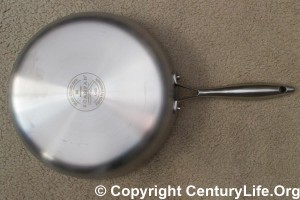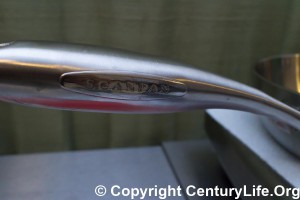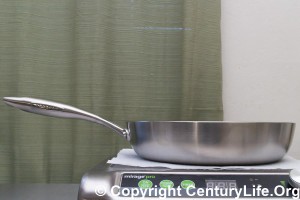
THE COMPANY
Scanpan (“Scan” for “Scandanavian” since they are made in Denmark; “pan” meaning cooking pan) is a Danish company founded in 1956.1
Scanpan is perhaps better known for its nonstick Scanpan CTX line of cookware–which Scanpan tries its best to portray as something other than a PTFE/Teflon pan even though it is in fact a PTFE/Teflon pan. That’s why they can only advertise it as PFOA-free instead of both PFOA- and PTFE-free. (Those acronyms are confusing; if you need to refresh your memory on the difference, click here.) Scanpan is not the only European cookware maker that tries to cover up its use of PTFE; Woll and Swiss Diamond
do the same.
But Scanpan also makes a Scanpan CSX product line that is constructed similarly to All-Clad Stainless, with three visible layers: an interior 18/10 stainless steel cooking surface layer, a middle layer of aluminum alloy, and an exterior 18/0 magnetic stainless steel exterior that makes the pan compatible with induction stoves. (The overly-enthusiastic Scanpan marketers count the microscopically thin bonding layers of aluminum as separate layers, but in actuality it has just as few layers as All-Clad Stainless.)
THE PRODUCT BEING REVIEWED
Today, we’re reviewing the Scanpan 67102800 CSX Covered Sauté Pan, 11-Inch (28cm) which is shaped like a deep skillet and comes with a stainless + glass lid. (I normally review the 28 or 30cm diameter skillet in a product line first, because it undergoes the most thermal stress of any piece of cookware, having to distribute much hotter heat a longer distance than smaller skillets. But the CSX product line has only 26 cm
and 32 cm
diameter skillets, hence why I was forced to review the 28 cm diameter sauté pan.)
Although this review is for the sauté pan, it is applicable to the rest of the Scanpan CSX product line.

Overall Rating: 4.1/5 Very Good. For an explanation of ratings methodology, click here.
Cleanup: 3/5 Good. I never give 5/5 to stainless steel because it can stick, but if you preheat the pan, then turn down the heat to low (or medium low depending on your burner’s strength) and add oil, and then add food, you can minimize sticking. Deglazing a pan (adding a little liquid such as wine to stuck-on bits of protein while the pan is still hot) can also help with cleanup as well as make a great pan gravy.
As far as stainless pans go, I would rate Scanpan CSX as average for interior-surface cleanup. It can be a pain to clean stuck-on grime around rivets, but I won’t take a point off just for that. Somewhat problematic is how the pan does not have flared rims, so it has a tendency to spill liquid down the exterior when pouring. The combination of so-so surface cleanup, rivets, and drippy sides makes me take off another point more than I would with better stainless steel pans. There’s really no excuse for Scanpan to not have flared rims at this price point.
If you ever find yourself with dull protein stains or rainbows of heated oil left on the pan, try boiling a little vinegar and water in the pan. If that’s not enough, use Bar Keepers Friend.

Durability: 5/5 Excellent. The interior stainless steel is SAE 304 (also known as 18/8 or 18/10 stainless steel) and resists corrosion quite well. The cladding is quite robust and it’s actually a little thicker than All-Clad Stainless at 3 mm as measured via micrometer (compared to 2.6 mm for All-Clad Stainless). This product line should resist warping well, and in fact I have yet to see any evidence of warping with this pan.
The manufacturer rates it oven-safe up to 550F (288C), so feel free to use it in the oven.
The lid fits reasonably tightly, but not so tightly that it will be a problem prying off.
Even heating: 4/5 Very Good. You won’t find this pan listed in the thermal (even heating) rankings, because it’s a sauté pan, so its shape and size make it not directly comparable to skillets. That said, given its thickness it should perform a little better than All-Clad Stainless and perhaps as well as Demeyere 5-Plus which has identical total thickness (3mm). I can also tell you that this sauté pan tested very well in practice, with little hot-spotting.
Heat retention is good, though a large amount of food such as a steak will crash the temperature of the pan harder than thicker pans like Demeyere Proline, resulting in more time spent steaming food and less time browning and developing flavor via Maillard reactions. This is more of a problem for high-temperature frying, though. This is a sauté pan, and for its intended purpose, the thermal performance is excellent.
Handling and ease of use: 4/5 Very Good. The handle is not uncomfortable, though it has a bulbous central part (see photos) and is not particularly easy to keep from rotating and spilling the contents of the sauté pan. I’m going to take a point off for the combination of the not-quite-right handling and the lack of a helper handle for a sauté pan of this size and weight.
Speaking of weight, the pan weighs 1530 grams (3.37 pounds) empty and has a pretty generous capacity which I’d estimate to be at least 3.5 quarts, so it really should have a helper handle since the fully-loaded weight of such a pan could be well over 5 pounds, which is too much for some people to “jump” with sauté motions anyway (where you shuffle the food using a series of elliptical motions with one arm).
As an aside, the bottom flat cooking diameter of this pan is nearly 9 inches, which is why it more resembles a particularly deep skillet rather than most sauté pans that have a much harder 90-degree bend at the sidewall.
Value: 4/5 Very Good. If you don’t mind the lack of helper handle and flared rims, this pan is a pretty good value compared to the competition .
Versatility: 5/5 Excellent. This pan can cook on any heating surface including induction. It is also dishwasher compatible and oven safe up to 550 degrees Fahrenheit (288 Celsius). Lastly, although it lacks flared rims, Scanpan has sealed the rims entirely so that there is no aluminum exposed. Harsher dishwasher detergents can slowly eat away at aluminum, so for those of you who want to be able to use harsh detergents in your dishwasher, this is one of the rare product lines that shrugs off such abuse. (Cristel Casteline is another.)
CONCLUSION
If you don’t mind the lack of flared rims and helper handle, the sauté pan is a good value which performs quite well thermally.
If we disregard price, its closest competitor would be the similar-performing, equally thick Demeyere 5-Plus, which has the added advantage of a slicker than normal stainless steel finish and no rivets to clean around.
However, CSX costs less, so for those on a budget who still want something similar in construction to All-Clad Stainless, but with higher thermal performance, the Scanpan CSX product line is worth considering. It’s also made in Denmark, not China like many cheaper All-Clad Stainless knockoffs. And lastly, it is one of the very few cladded product lines that has completely sealed rims, which makes the product impervious to even the harshest dishwasher detergents. That’s probably not important to some people, but it may be important to others.
FOOTNOTES




